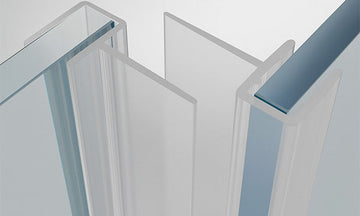
Shower seal strips are essential components that ensure a watertight and hygienic bathroom environment. Installed along the edges of shower doors—especially glass doors—they prevent water from leaking onto the bathroom floor. Beyond water containment, they also stop drafts, reduce noise, and in some cases, add a soft-close buffer when doors are shut.
The most common shower seal strips are made from PVC, vinyl, or silicone, and they come in designs suited for straight or curved glass, frameless shower doors, and even sliding panels. On sites like Quality Glass Fittings, you can find seal strips tailored for different glass thicknesses, often ranging from 6 mm to 10 mm. Choosing the correct one ensures maximum performance and longevity.
Types of Shower Seal Strips
1. PVC Seal Strips
PVC (polyvinyl chloride) seals are rigid yet flexible enough to grip glass edges securely. They’re affordable, easy to cut to size, and available in both transparent and frosted finishes. A typical example is the SE-251-8 Glass H Seal + Soft Leg, which snaps onto the bottom of an 8 mm glass door to create a clear, unobtrusive seal. PVC seals are ideal for everyday use but may stiffen over time in very hot or cold environments.
2. Vinyl Seal Strips
Vinyl offers more flexibility than rigid PVC, making it suitable for seals that need to contour slightly. Vinyl strips often come with a soft fin or sweep at the bottom to direct water back into the shower tray. They are a great choice for curved glass doors or uneven bathroom floors.
3. Silicone Seal Strips
Silicone is the premium option. It’s exceptionally flexible, resists mould and mildew, and retains elasticity over many years. Silicone seals are perfect for high-traffic bathrooms and are often used where superior sealing is critical—such as in walk-in showers with minimal thresholds.
4. Magnetic Seal Strips
Magnetic seals are commonly used where two glass doors meet in the middle, such as on bi-fold or pivot shower doors. They feature embedded magnets that pull the doors tightly together, preventing water escape and enhancing stability.
5. Fin Seal Strips
These have a thin, flexible fin that brushes against the opposing surface. They are used to close gaps and can be paired with other seal types to provide additional splash protection.
How to Choose the Right Seal for Your Shower Door

1. Measure Your Glass Thickness
This is the first and most important step. Shower seals are designed to fit snugly over specific glass thicknesses—often 6 mm, 8 mm, or 10 mm. Using the wrong size can lead to loose fitting or damage.
2. Identify Your Door Style
- Frameless hinged doors often use bottom sweeps or side seals.
- Sliding doors typically require top guide seals and vertical closing seals.
- Bi-fold doors benefit from magnetic closing strips.
- Curved doors need flexible materials like vinyl or silicone.
3. Choose the Material
PVC is cost-effective and rigid; vinyl is flexible and budget-friendly; silicone is premium and long-lasting. For areas with frequent water exposure and high use, silicone is worth the investment.
4. Consider the Seal Function
- Water deflection: Bottom sweeps direct water away from door gaps.
- Gap filling: Side seals or fins close spaces between the glass and wall.
- Soft closure: Magnetic strips enhance door closure and sealing.
5. Match the Finish
Most seals are clear for a discreet look, but frosted finishes can provide extra privacy or blend with frosted glass panels.
Step-by-Step Installation Guide
Tools you’ll need:
- Measuring tape
- Fine-tooth hacksaw or PVC cutter
- Soft cloth
- Mild cleaning solution
- Rubber mallet (optional)
Steps:
- Remove the Old Seal
Gently pull the existing strip away from the glass edge. If it’s stuck, use warm water to soften it.
- Clean the Glass
Remove any residue, limescale, or soap scum using a mild cleaner. Dry thoroughly.
- Measure and Cut the New Seal
Measure the door edge precisely. Cut the seal to length with a hacksaw or PVC cutter for clean edges.
- Fit the Seal onto the Glass
Align the seal’s channel with the door edge and push it on evenly. For tighter fits, gently tap into place with a rubber mallet, protecting the seal with a cloth.
- Check Alignment
Ensure that bottom sweeps or fins are angled correctly to deflect water into the shower tray.
- Test the Seal
Run the shower briefly to check for leaks. Adjust if necessary.
Also read: Top-Selling Glass Balustrade
Maintenance and Replacement Tips

- Regular Cleaning
Wipe seals weekly to prevent mould and soap build-up. Use non-abrasive cleaners to avoid scratching.
- Inspect for Damage
Look for cracks, discolouration, or stiffness—these indicate it’s time for replacement.
- Prevent Limescale Build-Up
In hard water areas, spray seals with a vinegar solution monthly.
- Replace When Necessary
On average, seals last 1–3 years depending on use and material. PVC may need replacing sooner than silicone.
- Lubricate Magnetic Seals
Occasionally wipe magnets with a damp cloth to keep them free from debris for a tight seal.
Conclusion and Buying Advice
Shower seal strips might seem like a small detail, but they play a critical role in keeping your bathroom dry, safe, and looking great. The key is to measure accurately, choose the right material, and match the seal to your shower door style.
For a wide range of high-quality shower seals, suppliers like Quality Glass Fittings offer products tailored to different glass thicknesses and installation types. Whether you opt for an affordable PVC sweep or a premium silicone fin, correct installation and regular maintenance will ensure years of reliable performance.
Quick Buying Checklist:
- Glass thickness (e.g., 6 mm, 8 mm, 10 mm)
- Door type (hinged, sliding, bi-fold)
- Material preference (PVC, vinyl, silicone)
- Function needed (water deflection, gap filling, closure)
- Aesthetic choice (clear, frosted)

